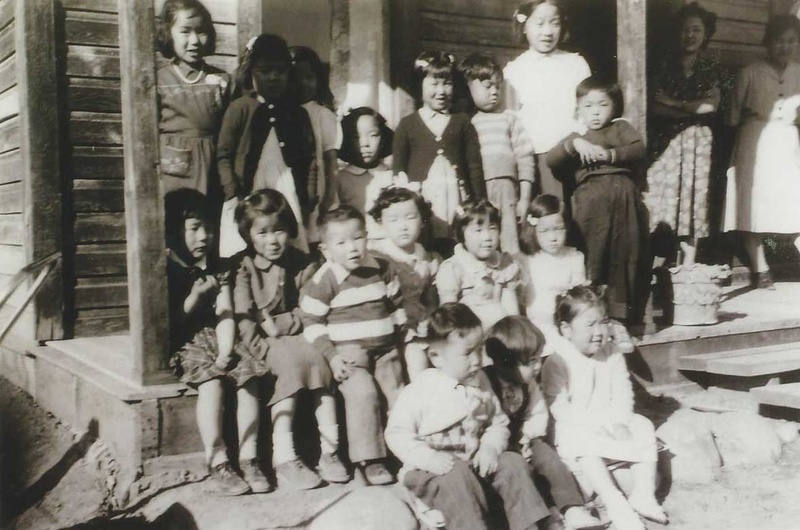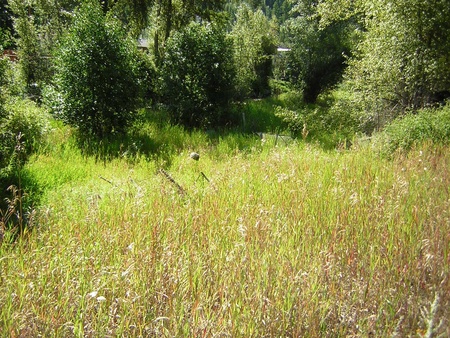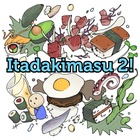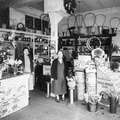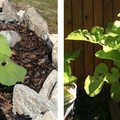Itadakimasu. What’s that? I never heard of it when I was growing up in postwar Canada. Japanese Language School didn’t exist in Greenwood. The only word similar to that was “Itai!” or “Itai-na!” when your older brother or sister was shoving you aside to get the best seat at the kitchen table. Besides, we all wanted to be more “Canadian-ized,” that is Anglo-Canadian culture. At Sacred Heart School, we children learned to sing “Irish Eyes are Smiling” or “Loch Lomond.” Even though the food was bland compared to Japanese food, it was a treat to have the nuns provide us with peanut butter/jam sandwich and hot chocolate (cacao) at the school banquet. One Labour Day festival, hot dog was free. This one Nikkei boy bragged that he ate seven ‘dogs! I remember going to his place to play and I saw him rushing his food. All I saw was mounds of rice with a sprinkling of bologna bits and cabbages. Wow! I didn’t complain about our meal after that.
In the comfort of our home, we could eat anything we wanted without feeling embarrassed. Our family was lucky, in that we ate well. Instead of saying “itadakimasu,” I would get excited when I smelled a big pot of curry, “Yay, my favourite ‘Ka-re gohan’!” Coming from a large family of nine, etiquette wasn’t mandatory. Actually, there was no structure at all at the kitchen table. If you were last to sit down, you lost out on the second serving. The Tasaka kids ran home for lunch from school. Sometimes, it was chaotic! Brothers and sisters fought for seating position, chopsticks waving wildly to get at the okazu, and some would take double scoops of rice so that they didn’t need to go for seconds. Pour the curry stew over your rice and it was motor city, eat quickly! Grab the tsukemono with your fingers! Crush the iwa nori between the palms of your hands. With ka-re gohan, however, the big pot provided enough for second servings.
If the meal was fish or hamburger patties, chopsticks became spears and kids stabbed at them. Older brother or sister was very cagey. One would say, “Hey, there’s a woodpecker!” I turn to look out the window and when I sat down again, one meat was gone! It was chaos! Crying and laughing galore. Oh, how did our parents ever put up with that daily?
When our parents served sashimi, kazunoko, ikura, or abalone, some of the children didn’t like things raw. One sister didn’t complain, and she would go to the breadbox to make her own sandwich. I never did like sashimi in my youth, but my parents and some of the fish-loving brothers savoured such delicacies. If I did try sashimi, I would smother it with soy sauce and grated ginger. I took a small piece and gobbled a mouthful of hot rice! That was my initiation to raw fish.
I couldn’t imagine how the fishing village of Steveston Nikkei could eat fish daily. My parents came from this village that is situated beside the mighty Fraser River. Then, I found out these Issei from Mio Mura, Wakayama, Japan found many ways to prepare fish. One of my favourites, satozuke, is a poorer quality salmon that is put in a brine for several days. Then, brown sugar is applied to marinate. Satozuke is broiled and it makes a great dish to go along with “okai-san” or okayu. Ta-re is the fatty belly part of the fish that is a delicacy. Salmon could be broiled, fried, grilled, smoked, salted, and cooked in sweetened soy sauce or added in mizutaki. Kamaboko (fish cake) is another fish product using chum or dog salmon. Side dish of tsukemono could be made from cucumber (beer pickle), spinach, cabbage, and/or daikon.
Our meals consisted mainly of fried bologna, sliced Prem or Spam, and in season, saya endo (snow peas) and fried bacon bits. In the spring and summer, trout caught at the creek provided us with fresh fish. Rainbow trout was our favourite. In the fall, it was hunting season, so we would have roasted blue grouse or venison. Venison had a gamey taste so my parents would use it to make stew. For side dishes, there would be tofu and all kinds of tsukemono. Ajinomoto and soy sauce were always placed on the table, and sometimes ketch-up.
The outhouse in the early ’50s was built close to the kitchen and the back steps. Why? Most young children were too afraid of the dark to walk a long distance. In the winter, it was too frigid to walk in the snow, let alone trying to sit on the frozen bench! In the summer, it was even worse! The flies came for lunch too! Even when dad had screen windows and doors, somehow flies got in when someone opened the door. I could relate to Zato Ichi when he would catch a fly with his chopsticks. We had a rolled-up newspaper handy. Dad had this sticky, curly tape contraption that hung from the ceiling to catch flies. How did we survive? I guess we became immune to germs and bacteria. Survive we did.
The situation changed completely with our dietary needs when we attended school. Although, I never ate lunch at school, my youngest brother wanted to join his classmates at lunch hour. Therefore, my sister prepared sandwich, fruit, and hot chocolate for him. No Nikkei dared to take rice balls (onigiri), teriyaki wiener, and egg omelette to school. If one did, other Nikkei kids would be embarrassed because that’s “Japanese” food. Most Japanese Canadians were self-conscious of displaying anything “Japanese” in public. I remember warning mother not to wear zori to go shopping or wear a yukata.
There was one exception. At May Day track and field competition, no Nikkei athlete would have enough energy by eating just sandwich. Mothers had to provide “chikara ryori” with rice balls, teriyaki wieners, egg omelette, and nori. The Nikkei parents would search for a big tree farthest away from school. They placed the blankets under the tree for shade and laid out the picnic food. Kids ate in secrecy by covering the hand over the onigiri. This was a time it wasn’t cool to be “Oriental”. Most tried hard to be accepted into the mainstream society.
How ironic is it now? There are more sushi places on the west coast than some of the fast-food franchises. Obento, ikura, uni, and okonomiyaki are not foreign words anymore. At Powell Street Matsuri, there are just as many Caucasians wearing yukata or trying on kimono. Health-conscious hakujin are drinking matcha and a variety of green tea over coffee or black tea. My friend was raving about how he drinks lot of green tea. I replied that “we” have been drinking it for thousands of years! How times have changed.
Present day Nikkei Canadians could go to any high-end restaurant and order steak and lobster. The Issei must be drooling in their ohaka. For the Nisei, it’s a far cry from eating mostly rice with bits of okazu that consisted of homemade tsukemono, Spam, or bologna. Yonseis think nothing of spending $15–20 for burger and chips.
Some Nisei try to keep alive the traditional “Japanese” food that is uniquely Nikkei. New Denver (Denbazuke) pickles, Kan-bah-lan-doh chow mein from Cumberland, B.C., Fuki (bogs rhubarb), matsutake and nori tori, kinpira (burdock roots), and karinto in teriyaki glaze, and teriyaki wieners. Will these dishes become extinct in time when most Nikkei are Hapas?
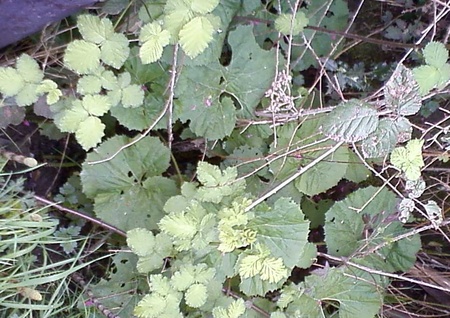
© 2017 Chuck Tasaka


